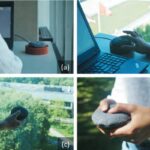ViBreathe: Heart Rate Variability Enhanced Respiration Training for Workaday Stress
Management via an Eyes-free Tangible Interface
Slow breathing guiding applications increasingly emerge, showing promise for helping knowledge workers to better cope with workaday stress. However, standard breathing guidance is non-interactive, with rigid paces. Despite their effects being proved, they could cause respiratory fatigue, or lack of training motivation, especially for novice users. To explore new design possibilities, we investigate using heart rate variability (HRV) data to mediate breathing guidance, which results in two HRV-enhanced guidance modes: (i) responsive breathing guidance and (ii) adaptive breathing guidance. These guidance modes are implemented on a soft haptic interface named “ViBreathe”. We conducted a user test (N = 24), and a one-week field deployment (N = 4) with knowledge workers, to understand the user experience of our design. The HRV-enhanced modes were generally experienced to reduce tiresome and improve engagement and comfort. And Vibreathe showed great potential for seamlessly weaving slow breathing practice into work routines. We thereby summarize related design insights and opportunities.
FULLTEXT: PDF REFERENCE: BibTeX EndNote
DOI: 10.1080/10447318.2021.1898827
